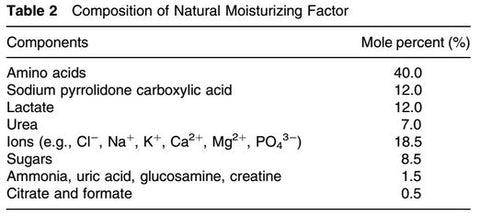October 11, 2019
Our stratum corneum contains free amino acids, and other nature occurring chemical lactic acid, urea, and sodium PCA, etc. These are called “natural moisturizing factors” and are responsible for keeping the skin moist and pliable by attracting and holding water.
NMF are humectants; they attract and hold onto water. The water content of the stratum corneum is about 30%. The proteolytic breakdown of filaggrin to amino acids only happens when the skin is dry to control the osmotic pressure of the skin and the amount of water it holds. The need for breaking down of filaggrin is less in humid weather than in dry weather. When the skin is occluded (or when the relative humidity is high), there is minimal breakdown of filaggrin. Drier conditions lead to an increase in proteolytic activity, resulting in the production of more NMF.
In summary, when the water content in the SC is decreased it activate the proteolytic enzymes to break down filaggrin into individual amino acids. These plus other chemicals form NMF in the stratum corneum holds water to rehydrate the SC.

*Info & Image source: Handbook of Cosmetic Science and Technology*
The NMF concentration varies with age and skin depth. For healthy skin, not exposed to surfactant damage, the NMF content is independent of depth until one approaches the filaggrin-containing levels of the skin. In the deeper stratum corneum layers of older individuals (50-65 yrs) the NMF concentration is low. This is a reflection of the skin’s diminished ability to degrade filaggrin.
Some NMF behave as simple humectants and have other functions. Lactate and potassium, for example, affect the pH and stiffness of the stratum corneum. The L-isomer of lactic acid also stimulates ceramide biosynthesis and improves barrier function. Two additional NMF, Hyaluronic acid (HA) and glycerol, have also been found in the stratum corneum.
Like HA, glycerol also influences the skin’s pliability by interacting with skin lipids. Glycerol could modulate the phase behavior of intercellular lipids favoring a more pliable, liquid crystalline structure at low relative humidities.
*Info & Image source: Handbook of Cosmetic Science and Technology*
Comments will be approved before showing up.
April 07, 2025
Many of us dream of having bright, radiant skin that glows with health. Skin brightening treatments have become increasingly popular as they help reduce dark spots, even out skin tone, and restore a youthful appearance. Modern skin brightening treatments work by targeting melanin production, removing dead skin cells, and promoting cell turnover to reveal fresher, more luminous skin underneath.
January 28, 2025
Finding the right face mask for sensitive skin can be tricky. Many masks contain strong ingredients that may irritate delicate skin. But don't worry - there are great options out there.
January 27, 2025
Oily skin can be tricky to manage, but hyaluronic acid might be the secret weapon you've been looking for. This powerful skincare ingredient is known for its ability to hydrate and plump the skin. You might think adding moisture to oily skin is counterintuitive, but it's actually quite beneficial.
